Top 8 "what the hell is that?" urban animals
Since I've made myself into a guy people ask about urban nature, I've noticed a bunch of recurring characters in the questions people ask. I thought it might be interesting or useful to make a list of the creatures that most often inspire a "what the hell is that?" reaction. These animals have a special value as gateways to an interest in nature for city people. When someone is startled by something that seems unusual or exotic, it's a great way to start to appreciate life for its own sake.
#8: European starling Sturnus vulgaris
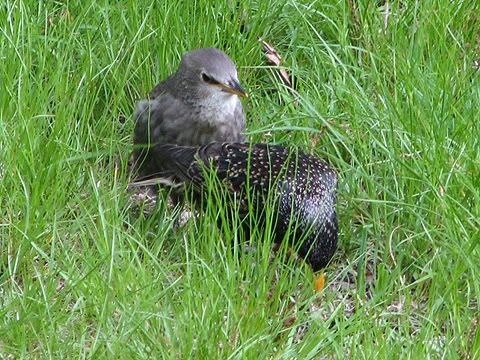
Most urban people never even notice this most common of city birds. Smaller than pigeons, without that bird's habit of lingering in parks for handouts, starlings are below the notice of laypeople. This changes when they find a young starling, separated from its parents, seemingly helpless. The nestling is the same size an adult (a fact common to songbirds that is a source of much bafflement to those new to the study of nature) but less shy of humans. Sometimes the bird is stunned by having struck a window or otherwise reluctant to fly. The would-be good Samaritan scoops the bird into a box and goes online looking for advice on how to care for their little patient. They are then amazed to discover that they have rescued a bird that is hated by bird lovers. This paradox can only disentangled by learning the history of starling introduction, and the subsequent disastrous effects on native birds. Not the most pleasant way to begin learning about urban nature, but it may be the first awakening that there are many stories of the animals in the city, and they may be interested to learn what animals are introduced, what are native, and the many ways humans have changed the path of nature.
#7: Freshwater bryozoan Pectinatella magnifica
When a mysterious glob of living jelly forms in your favorite fishing hole, you might be pretty alarmed. This colonial organism looks like a brain monster from outer space, but is in fact a harmless invertebrate that's lived on earth for half a billion years.
#6: Black-crowned night-heron Nycticorax nycticorax
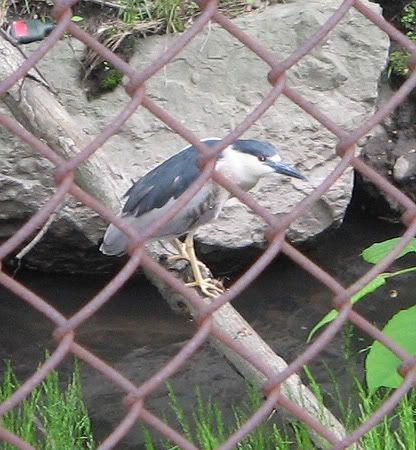
If they say they saw it by the water, it was about the size of a crow (or a football) and had dark cap, I know they saw a black-crowned night-heron. If they mention its red eyes or crouching posture, I'll know that they have good powers of observation, and should be exploring their world more often and discovering all kinds of living things. It isn't rare (it's the most widespread heron species in the world) but it is more secretive than a pigeon, and the very fact someone noticed one is a good indication that they are starting to look around themselves in a new way.
#5: Terrestrial flatworm Bipalium adventitium and other species.
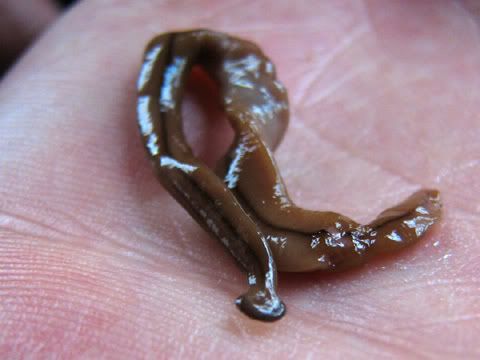
A personal favorite on this blog, the wandering broadhead planarian, or "landchovy" is a predator of earthworms. It's fully alien (from Indonesia or other points in south Asia), repulsive-looking and bizarre. Being a relatively recent introduction to North America, it often is reported with the phrase "I've never seen anything like it." A super long and stringy version is so far restricted to the southern states.
#4: Woodlouse spider Dysdera crocata

This is my most active 365 urban species post. Every couple of weeks or so I get an anonymous (no lj account) comment to the effect of "OMG I just found this spider in my house what do I do?!" The same thing you should do with any spider in your house. Appreciate its beauty and its service as a predator in the ecosystem of your home. It won't hurt your cat. Cat/spider interactions always favor the cat. This isn't Australia, for heaven's sake. See also: yellow sac spider, northern false widow.
#3: Crane fly Family Tipulidae
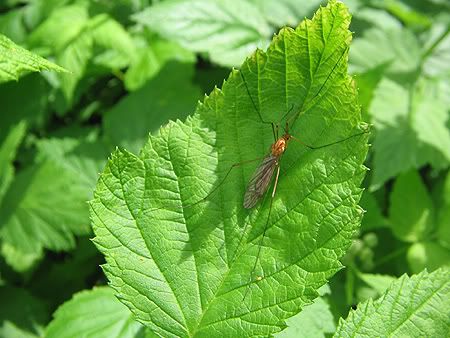
Counseling someone on these creatures involves dispelling the impression that they are giant mosquitoes, as well as the widely held but erroneous belief that they are mosquito predators. Like the vast majority of insects, they are neither great friends nor foes of humans.
#2: Farm duck/ mallard hybrid Anas platyrhynchos
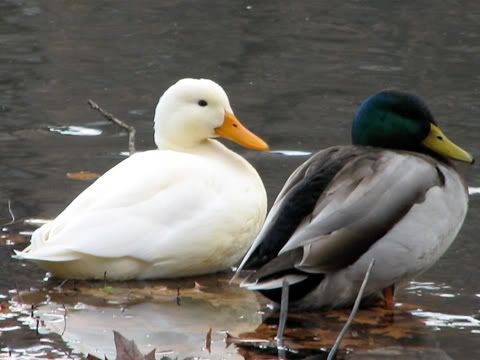
A person gets used to mallards: green headed males and brown camouflaged females. But what of this all-white duck? What about the mallard that's bigger than all the others, with a white spot on his breast? What about the female with a tumor-like pom-pom sticking off the back of her head? There are almost endless variations of ducks mixed in with the mallards, and for good reason: they are mallards. Most* of the farm ducks in the world can trace their ancestry to mallards. Unwanted ducks are released to urban ponds and freely breed with the wild ones, producing a baffling array of plumages not found in field guides. *The rest of the farm ducks in the world are derived from the muscovy duck Cairina moschata, which is distinguished by turkeylike fleshy patches around its eyes. It also can be found in city parks, in a variety of colors.
#1: House centipede Scutigera coleoptrata
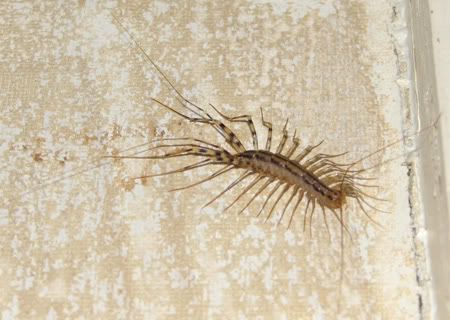
And the number one urban animal that causes people to say "what the hell is that?" is the house centipede. The first time you see one you almost have to say "What the hell is that?" Many people, instead, simply shriek. I've said it before and I'll say it forever until I'm proven wrong: no other animal, pound for pound, causes as much alarm as the house centipede. Fifteen pairs of spiderlike legs on a body with fused segments make this one of the fastest land animals on earth. The fact that this creature hunts pest insects does little to make people happy about its presence in the home. In northern climates it lives almost exclusively indoors, almost exclusively in urban places. There's a huge spike of interest in this animal in September, when students from suburban homes move into group housing and into city apartments, and discover how surprising urban wildlife can be.
#8: European starling Sturnus vulgaris

Most urban people never even notice this most common of city birds. Smaller than pigeons, without that bird's habit of lingering in parks for handouts, starlings are below the notice of laypeople. This changes when they find a young starling, separated from its parents, seemingly helpless. The nestling is the same size an adult (a fact common to songbirds that is a source of much bafflement to those new to the study of nature) but less shy of humans. Sometimes the bird is stunned by having struck a window or otherwise reluctant to fly. The would-be good Samaritan scoops the bird into a box and goes online looking for advice on how to care for their little patient. They are then amazed to discover that they have rescued a bird that is hated by bird lovers. This paradox can only disentangled by learning the history of starling introduction, and the subsequent disastrous effects on native birds. Not the most pleasant way to begin learning about urban nature, but it may be the first awakening that there are many stories of the animals in the city, and they may be interested to learn what animals are introduced, what are native, and the many ways humans have changed the path of nature.
#7: Freshwater bryozoan Pectinatella magnifica
When a mysterious glob of living jelly forms in your favorite fishing hole, you might be pretty alarmed. This colonial organism looks like a brain monster from outer space, but is in fact a harmless invertebrate that's lived on earth for half a billion years.
#6: Black-crowned night-heron Nycticorax nycticorax

If they say they saw it by the water, it was about the size of a crow (or a football) and had dark cap, I know they saw a black-crowned night-heron. If they mention its red eyes or crouching posture, I'll know that they have good powers of observation, and should be exploring their world more often and discovering all kinds of living things. It isn't rare (it's the most widespread heron species in the world) but it is more secretive than a pigeon, and the very fact someone noticed one is a good indication that they are starting to look around themselves in a new way.
#5: Terrestrial flatworm Bipalium adventitium and other species.

A personal favorite on this blog, the wandering broadhead planarian, or "landchovy" is a predator of earthworms. It's fully alien (from Indonesia or other points in south Asia), repulsive-looking and bizarre. Being a relatively recent introduction to North America, it often is reported with the phrase "I've never seen anything like it." A super long and stringy version is so far restricted to the southern states.
#4: Woodlouse spider Dysdera crocata

This is my most active 365 urban species post. Every couple of weeks or so I get an anonymous (no lj account) comment to the effect of "OMG I just found this spider in my house what do I do?!" The same thing you should do with any spider in your house. Appreciate its beauty and its service as a predator in the ecosystem of your home. It won't hurt your cat. Cat/spider interactions always favor the cat. This isn't Australia, for heaven's sake. See also: yellow sac spider, northern false widow.
#3: Crane fly Family Tipulidae

Counseling someone on these creatures involves dispelling the impression that they are giant mosquitoes, as well as the widely held but erroneous belief that they are mosquito predators. Like the vast majority of insects, they are neither great friends nor foes of humans.
#2: Farm duck/ mallard hybrid Anas platyrhynchos

A person gets used to mallards: green headed males and brown camouflaged females. But what of this all-white duck? What about the mallard that's bigger than all the others, with a white spot on his breast? What about the female with a tumor-like pom-pom sticking off the back of her head? There are almost endless variations of ducks mixed in with the mallards, and for good reason: they are mallards. Most* of the farm ducks in the world can trace their ancestry to mallards. Unwanted ducks are released to urban ponds and freely breed with the wild ones, producing a baffling array of plumages not found in field guides. *The rest of the farm ducks in the world are derived from the muscovy duck Cairina moschata, which is distinguished by turkeylike fleshy patches around its eyes. It also can be found in city parks, in a variety of colors.
#1: House centipede Scutigera coleoptrata

And the number one urban animal that causes people to say "what the hell is that?" is the house centipede. The first time you see one you almost have to say "What the hell is that?" Many people, instead, simply shriek. I've said it before and I'll say it forever until I'm proven wrong: no other animal, pound for pound, causes as much alarm as the house centipede. Fifteen pairs of spiderlike legs on a body with fused segments make this one of the fastest land animals on earth. The fact that this creature hunts pest insects does little to make people happy about its presence in the home. In northern climates it lives almost exclusively indoors, almost exclusively in urban places. There's a huge spike of interest in this animal in September, when students from suburban homes move into group housing and into city apartments, and discover how surprising urban wildlife can be.